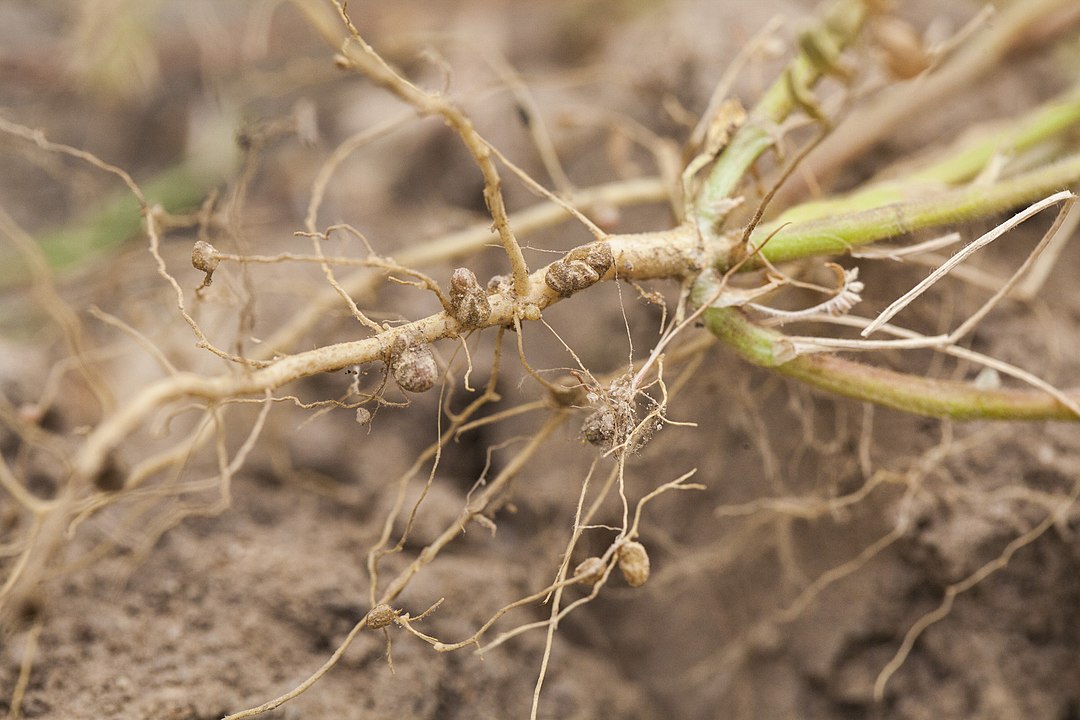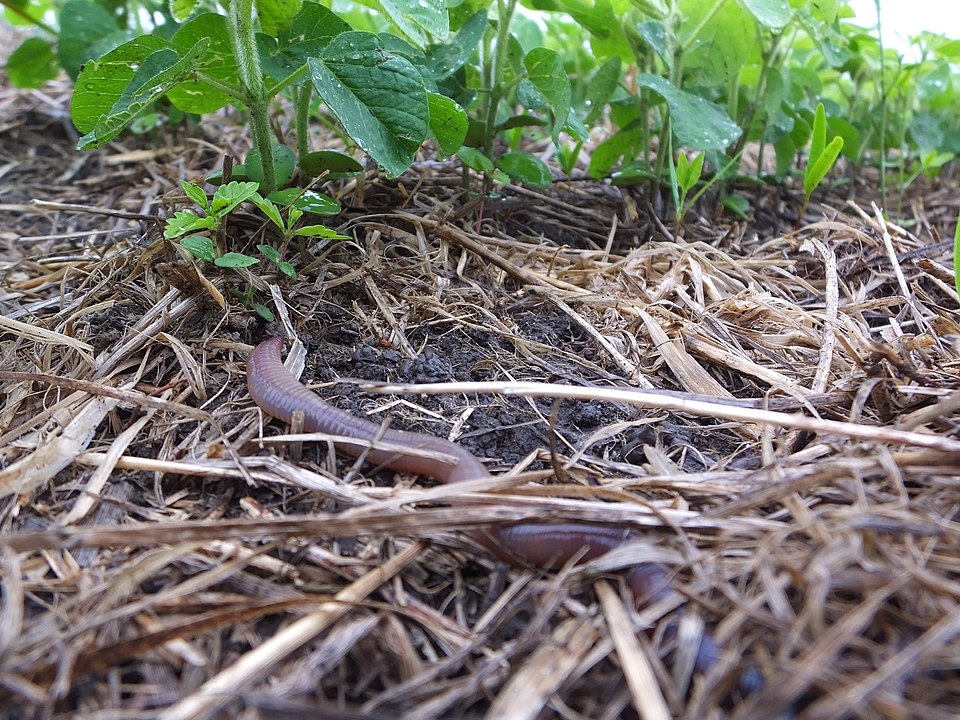Love Your Soil, Don't Dig It!
Traditionally gardeners have aimed for a perfect weed-free plot, digging it over every autumn so that the winter frosts and rain can break down the clods of soil. Organic gardeners have used this annual activity to dig in lots of manure or compost in order to improve the soil structure but are now beginning to question this practice.
The thought of all that heavy digging and lifting is enough to make anyone with an energy limiting illness, or indeed any physical challenges, give up on gardening but here’s the really good news:
No dig gardening is better for you and better for your plants!
That’s right, not only is it okay to avoid digging your garden when you are tired and in pain but it’s an activity to avoid even when you are fully fit; digging actively damages your soil – and therefore your plants – as well as your own health.
On this page I will give you an insight into the fascinating world of soil science, so you can understand what your soil is, why it is so important and how to look after it.
For ideas on how to create No Dig beds, have a look at my Activities pages.
The thought of all that heavy digging and lifting is enough to make anyone with an energy limiting illness, or indeed any physical challenges, give up on gardening but here’s the really good news:
No dig gardening is better for you and better for your plants!
That’s right, not only is it okay to avoid digging your garden when you are tired and in pain but it’s an activity to avoid even when you are fully fit; digging actively damages your soil – and therefore your plants – as well as your own health.
- Digging destroys your soil’s structure as well as the delicate and necessary balance of life within it.
- Digging increases the speed with which nutrients leach out of your soil, particularly when it is left bare and exposed to the elements over winter.
- Heavy digging and lifting are responsible for the huge numbers of gardeners living with chronic back pain and hand / wrist injuries.
On this page I will give you an insight into the fascinating world of soil science, so you can understand what your soil is, why it is so important and how to look after it.
For ideas on how to create No Dig beds, have a look at my Activities pages.
Use the links below to skip through the sections on this page
What is Soil?
The soil in your garden is composed of a mixture of tiny particles of stone and organic matter, or humus, which are bound together in crumbs allowing pockets of air between. These gaps allow your soil to hold huge quantities of water, like a sponge, and for the excess to drain down into the rock below. The top few inches – the topsoil – are richest in humus. This layer should be darker, have a crumbly texture and be criss-crossed with little channels made by worms and other animals. It should also smell earthy and sweet.
Your topsoil can be anything from a thin skimming to 30 cm or more deep. If you can dig a hole, you will see that below is a paler, more solid layer – the subsoil – which contains far less organic matter and animal life. It is rich in minerals, which deep-rooted plants bring up from the subsoil, adding these important nutrients to the topsoil as their leaves decay. Deep digging can mix the subsoil with your topsoil, damaging its structure and diluting its fertility.
Your topsoil can be anything from a thin skimming to 30 cm or more deep. If you can dig a hole, you will see that below is a paler, more solid layer – the subsoil – which contains far less organic matter and animal life. It is rich in minerals, which deep-rooted plants bring up from the subsoil, adding these important nutrients to the topsoil as their leaves decay. Deep digging can mix the subsoil with your topsoil, damaging its structure and diluting its fertility.
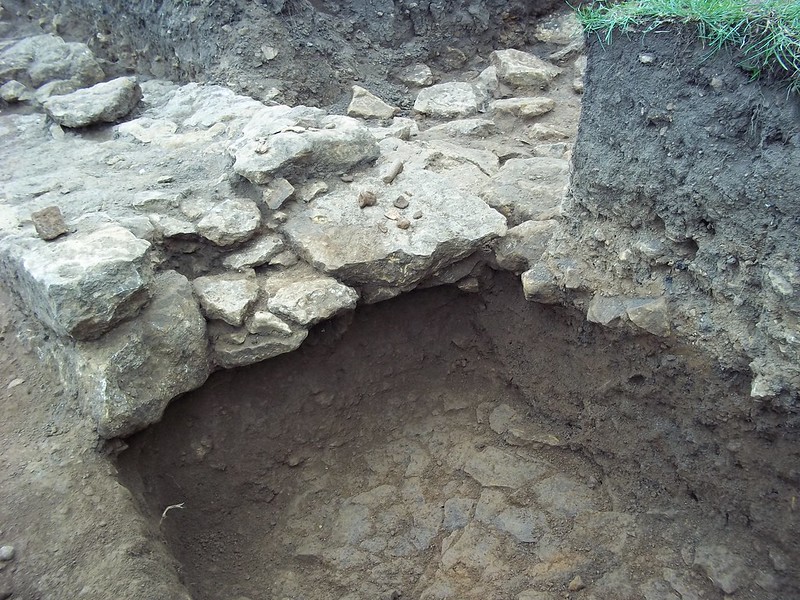
This image is from an archaeological dig that I was involved in years ago. On the right you can clearly see the soil layers. Under the grass is a layer of dark topsoil with roots growing down into it; beneath is a layer of rocky construction material, overlying paler subsoil. At the very bottom of the trench is a layer of ironstone bedrock. The original topsoil must have been cleared away before building. Once the building was demolished, nature created new topsoil as centuries of decaying plant material decomposed on top of what remained. Spot the tunnels created by worms and possibly voles above the paved layer.
The Mineral Element of Soil
The stone particles in your soil range from fine dust – or silt – through to large sand particles. The balance of these elements determines whether your soil is open and crumbly – sandy – or solid and heavy – clay. This aspect of your soil, along with its colour, depends on your local geology. In chalky areas, like those on the south coast, your soil will be pale and milky; in the south-west soils are an almost plummy purple; in Leicestershire our fields are a rich red-ochre colour from the ironstone beneath. I live in an area bordering two dramatically differing soil types. I used to have an allotment on the sandy soils of Lincolnshire, a few miles to the east, where the mineral portion of the soil has relatively big sandy particles. This creates large air pockets through which the rain drains quickly. As a result it warmed quickly in the spring and didn’t waterlog in the winter. However, the free-drainage meant that it dried out rapidly in the summer and nutrients washed out very quickly; keeping my plants well fed and watered was hard work. In my village the soil is the complete opposite – heavy clay. It is composed of tiny particles, which pack closely together with little space for air and so becomes waterlogged and is cold and wet in the spring.
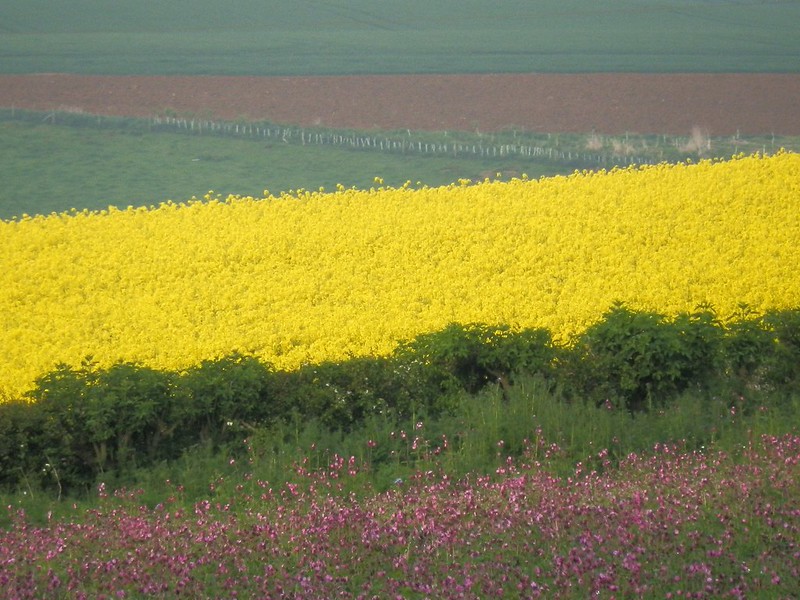
Stripes of cereal crop, ploughed soil, pasture, oil-seed rape, hedgerow and campion flowers that characterise my home county. I took this photo because of the striking colours, including the rich red soil that speaks of home.
The Organic Element of Soil
Soil is a living system and not just mud or dirt. It is a vital resource, which is both composed of and constantly renewed by living organisms. Without this cycle it dies and gradually reverts to mineral dust, incapable of growing anything.
The organic element of soil is found mainly in the top few centimetres. It has built up over thousands of years through the action of billions of bacteria, fungi, worms and other mini-beasts that have decomposed, or composted, dead vegetation and animal matter into a dark rich humus. The soil in woodland areas is particularly dark and rich in life as centuries of leaves have fallen and been incorporated into the soil. In contrast, soil that has been cultivated for long periods without the addition of organic matter, that has been dug or ploughed and left exposed to the elements, is pale, dusty and lacking in life.
When soil is drenched in pesticides and weed-killers the billions of bacteria, fungi and animals that compost dead material into humus die. There is nothing left to rot down dead leaves and animals, nothing to breakdown complex nutrients and make them available to your plants. The soil literally becomes a simple carrier for artificial fertilisers and is incapable of growing anything without them. Without the constant renewal of organic matter, without the protecting shelter and anchor of plant roots and canopies, the existing humus dries out and blows away in the wind or is washed away in the rain. What remains is the heavy mineral portion.
The organic element of soil is found mainly in the top few centimetres. It has built up over thousands of years through the action of billions of bacteria, fungi, worms and other mini-beasts that have decomposed, or composted, dead vegetation and animal matter into a dark rich humus. The soil in woodland areas is particularly dark and rich in life as centuries of leaves have fallen and been incorporated into the soil. In contrast, soil that has been cultivated for long periods without the addition of organic matter, that has been dug or ploughed and left exposed to the elements, is pale, dusty and lacking in life.
When soil is drenched in pesticides and weed-killers the billions of bacteria, fungi and animals that compost dead material into humus die. There is nothing left to rot down dead leaves and animals, nothing to breakdown complex nutrients and make them available to your plants. The soil literally becomes a simple carrier for artificial fertilisers and is incapable of growing anything without them. Without the constant renewal of organic matter, without the protecting shelter and anchor of plant roots and canopies, the existing humus dries out and blows away in the wind or is washed away in the rain. What remains is the heavy mineral portion.
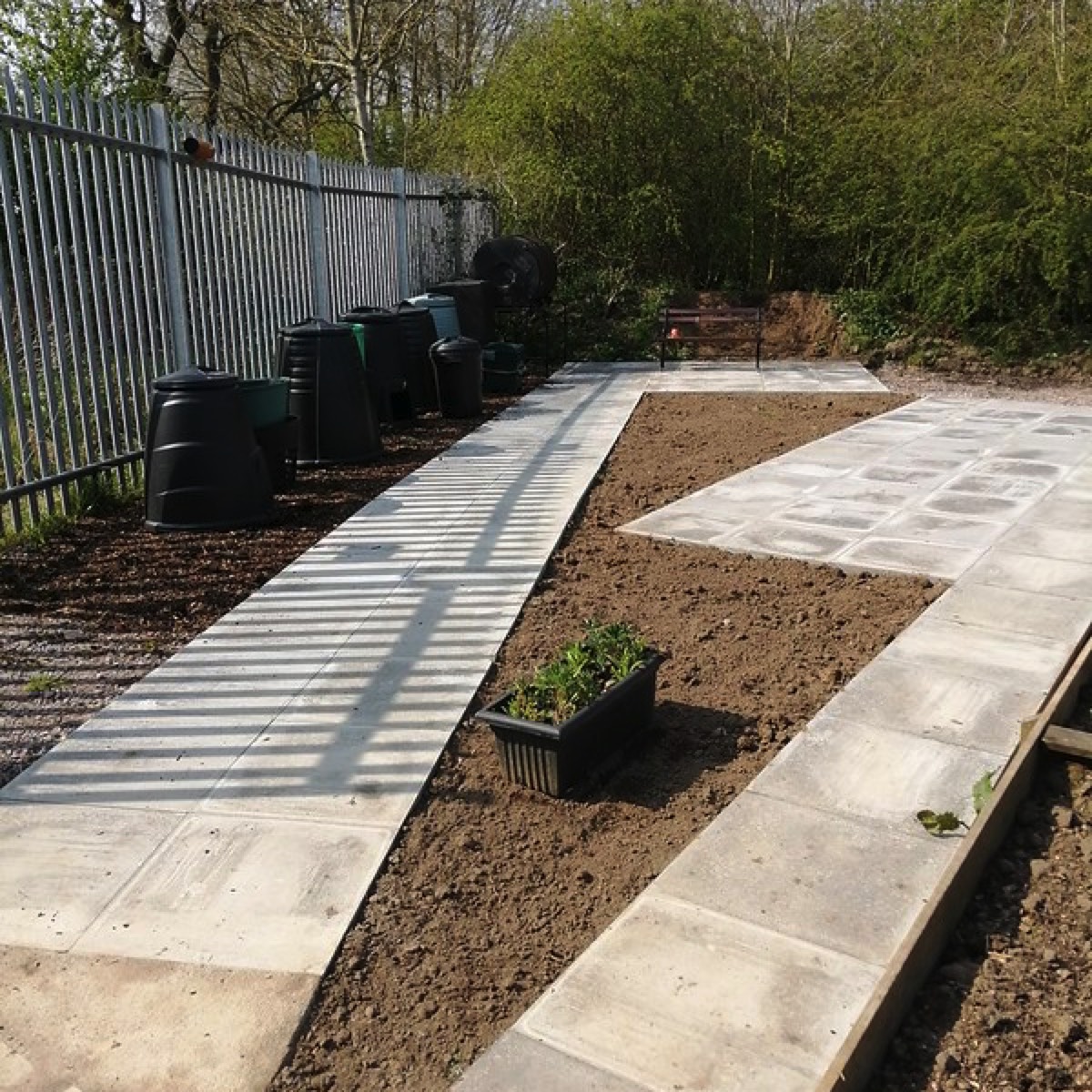
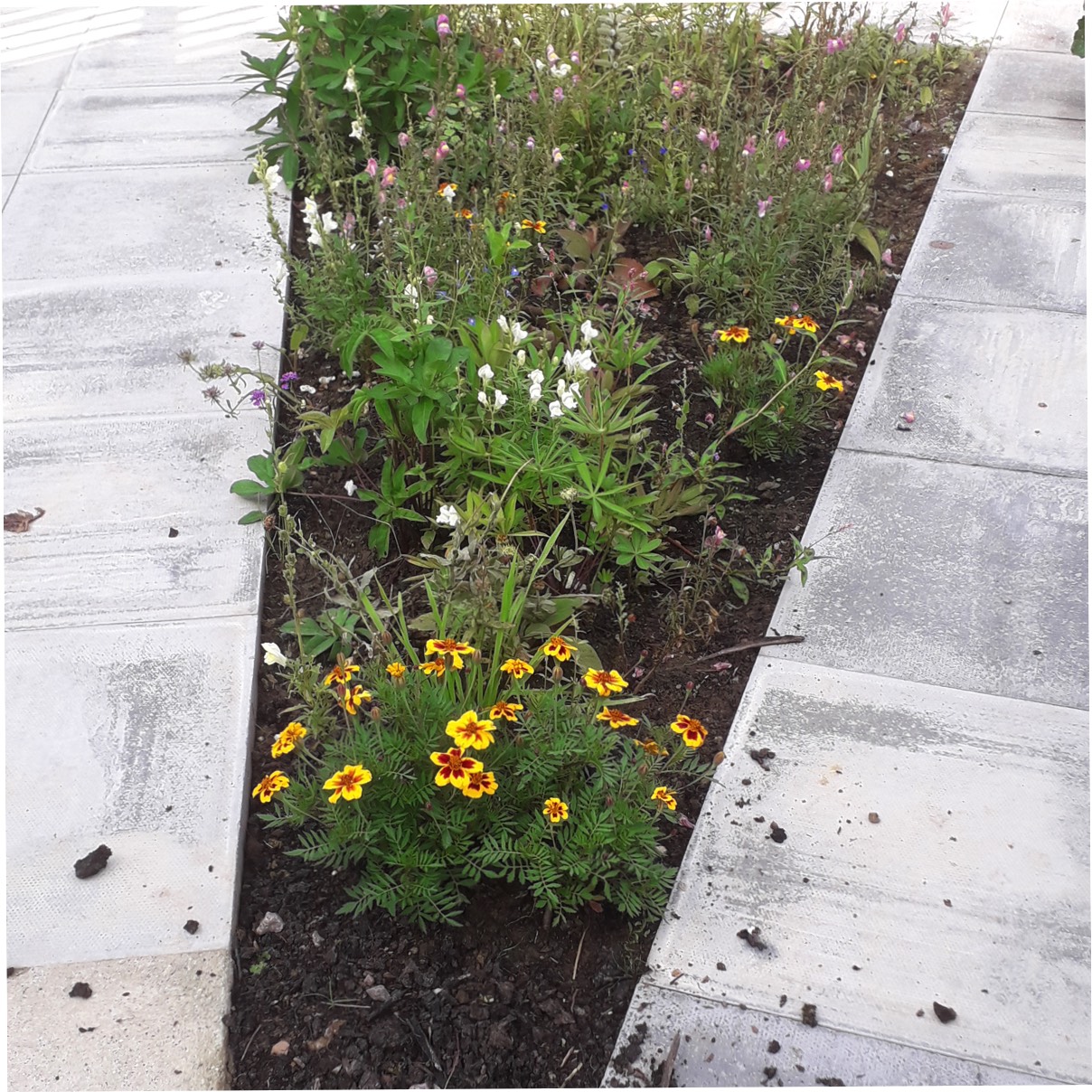
Compare the colour of the newly purchased topsoil on the left, and its dusty appearance, with the rich darkness of the same bed, pictured on the right, once it has been given a good mulch with compost. This is a newly created bed on a community garden I am involved with. For some reason the site was bulldozed of all topsoil before being given to the group and creating fertile new beds has been a major challenge. See below for more photos of our soil before and after restoration.
Soil Structure
In the paragraphs above I have written about the way in which your local geology affects your soil structure, from course and sandy to fine clay soils. The incorporation of large amounts of humus, whether by nature or by gardeners, gives any basic soil type a nice, airy, open structure. Mycorrhizal fungi within the humus produce a gummy substance called glomalin, which helps to bind the mineral and organic elements of your soil together into crumbs. The spongey texture that this produces holds moisture but also allows excess water to drain away, leaving air pockets that allow all the beneficial life within the soil to thrive. Beyond these crumbs, an open structure is created by millions of worms, nematodes and other mini-beasts that burrow through it, eating any dead organic matter they encounter and turning it into more soil.
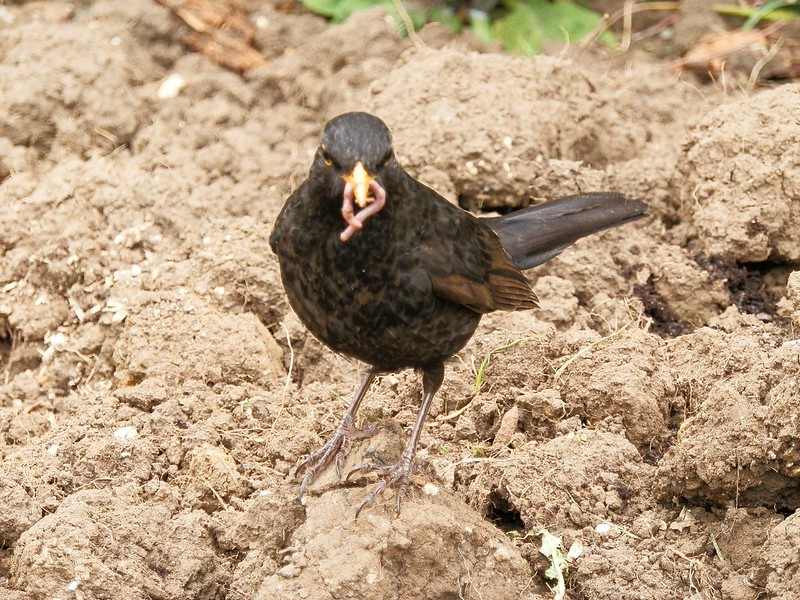
Blackbirds love gardeners who dig, as it helps them to access the worms and grubs in the soil, but they are also clever enough to lure worms to the surface of un-dug soil by pattering on the surface to imitate the sound of rain. Worms come to the surface to avoid flooding in their burrows.
Human scale digging, and exposure to rain, frost and wind, disrupts the network of fungi, breaks up the crumbs of soil that they have created and destroys the drainage network of worm channels. Walking, or driving across soil, particularly when it is wet, also destroys its structure, squashing the air pockets. Have you ever eaten cheap white bread and found it sticking in a claggy lump to the roof of your mouth, or squashed it between your fingers into a firm, grey unappetising lump? Pressure destroys the delicate structure of bubbles and there is no springing back into shape. Soil is the same; squash the bubbles and they disappear into a solid mass. Think of the rainy days when you have seen big puddles at the entrances to fields, where large agricultural machines have squashed all of these bubbles and compacted the soil. The same happens on footpaths or festival fields, trodden by thousands of feet, or on your lawn or flower beds if you walk on them during wet weather. Soil that used to have the structure of a sponge has been crushed into the equivalent of squished white-sliced bread.
Once the air has gone and the water cannot drain away, the life within your soil changes and is reduced to the small number of organisms that can survive without oxygen. It may sound crazy, but having a good sniff at your soil will tell you a lot about the type and variety of life within it:
Once the air has gone and the water cannot drain away, the life within your soil changes and is reduced to the small number of organisms that can survive without oxygen. It may sound crazy, but having a good sniff at your soil will tell you a lot about the type and variety of life within it:
- eroded soil with little humus has almost no smell and, if dry is so dusty that it will probably make you sneeze;
- compacted soil has a characteristic smell like blocked drains or dredged canals, a sign that it is dominated by anaerobic bacteria, producing methane and hydrogen sulphide;
- healthy well-oxygenated soil should smell sweet and delicious. Think of the scent of damp leaves in an autumn wood or freshly mown hay. I was once teaching a toddler and his mum to sow a windowsill salad when he pitched headfirst into the tray of compost we were working with and took an enormous mouthful. I had to agree it did smell good enough to eat!
A Tale of Two Sites: graphic examples of soil degradation and reconstruction
Soil Degradation
The photo below shows soil samples that I took from the edge of my local bluebell wood and from the field that borders it, just five metres away. Before it was ploughed, the soil in the field – the yellowish clay lump in this picture – would have had the same dark, crumbly appearance as that in the wood – the sample below it. However, it has been ploughed annually for decades with nothing more returned to it than liquid fertilisers. To make things worse, it has been sprayed with herbicides and fungicides that have destroyed the network of life that could return any dead matter to the soil. Heavy machinery has crushed the air from it and the exposure of bare, ploughed soil to the winds has blown away much of its desiccated humus as dust. In winter the surface of this field is smooth, hard and green with algae – as you can see in the sample on the top right – while the wood is covered in a dense growth of plants, which bind it together and keep it rich, open structured and fertile.
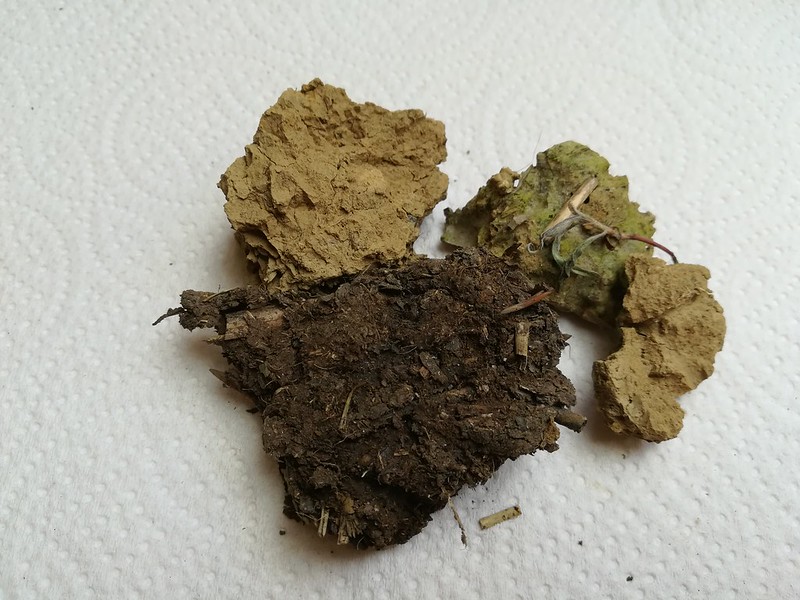
Yellow, compacted and lifeless field clay – top
Dark, crumbly, nutrient-rich woodland soil – bottom
Yellow compacted field clay, coated in algae – top-right
Dark, crumbly, nutrient-rich woodland soil – bottom
Yellow compacted field clay, coated in algae – top-right
The photos below contrast the vast expanse of exposed soil in a field bordering the bluebell wood with the lush abundance of life in the wood.

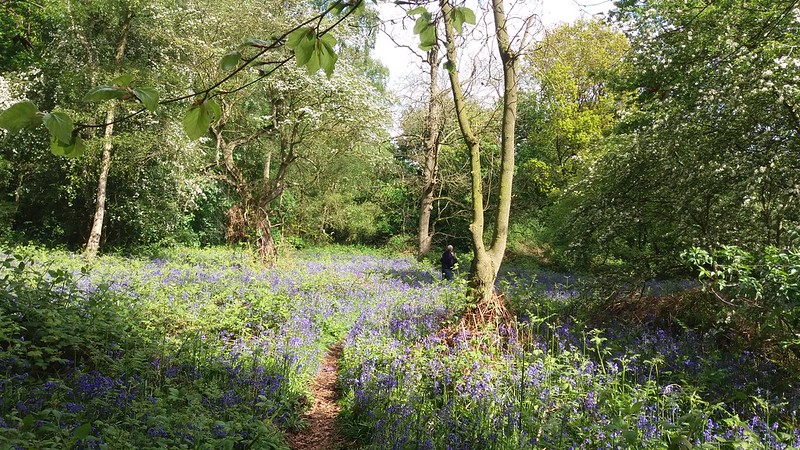
Soil Creation
Our community allotment site was scraped bare of its topsoil before being handed over to the group. Compare the yellow algae-infested swamp we were faced with when trying to erect a polytunnel . . .
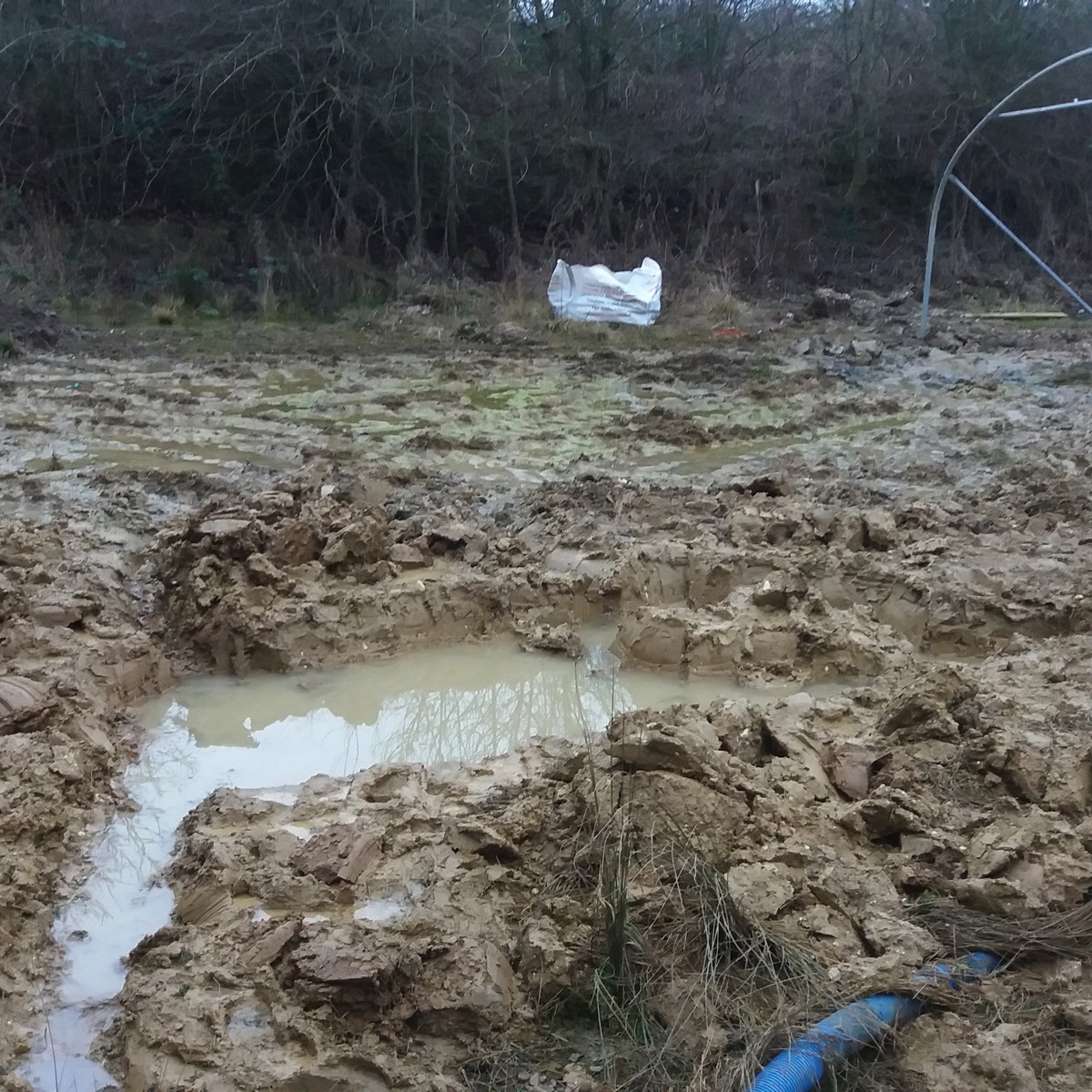
. . . with the same site in spring two years later after hours of barrowing manure and wood chips by a team of men from our local community payback programme.
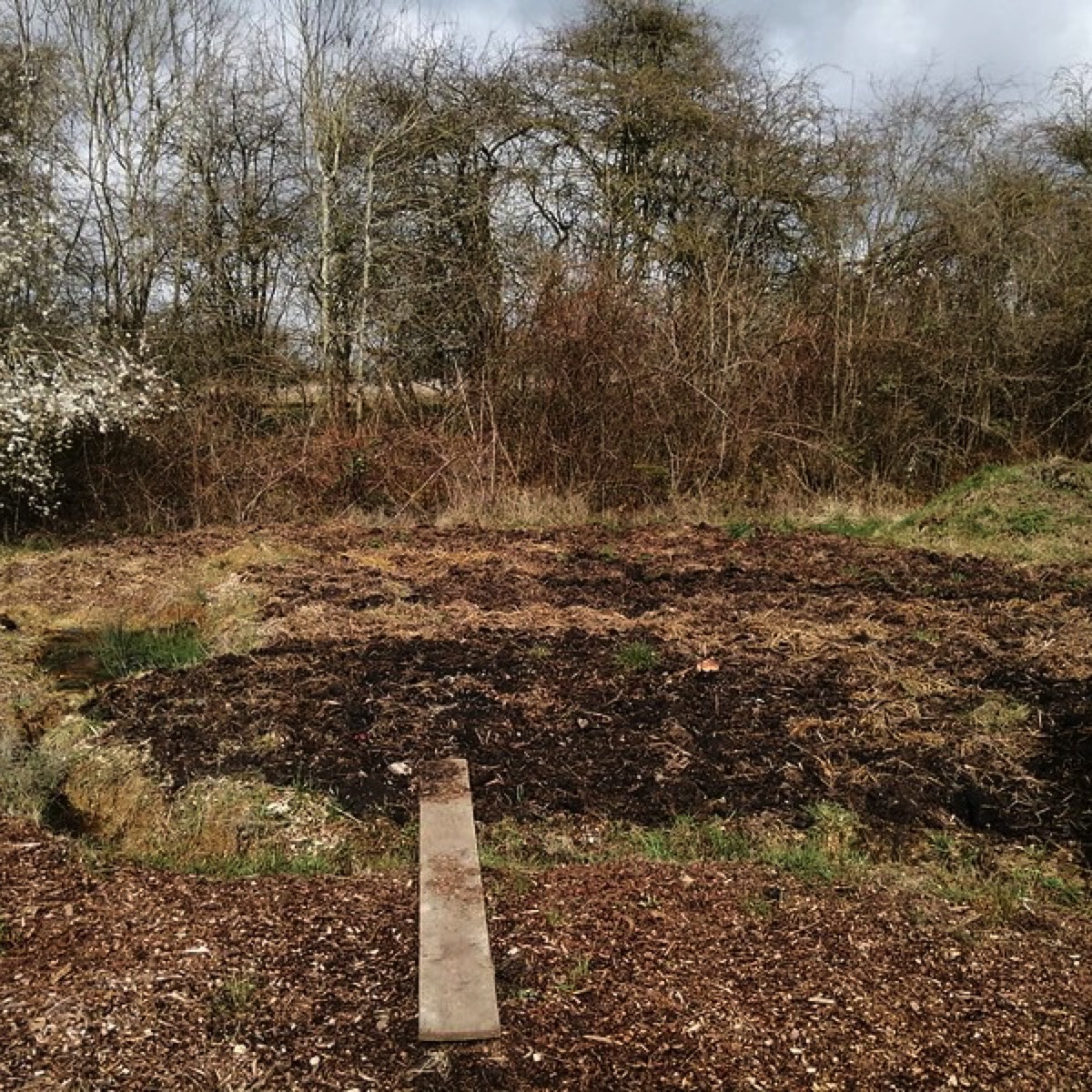
And finally . . . just look at the wilderness of plants that have colonised the new soil by the following summer. Eventually we plan to plant this area as an orchard.
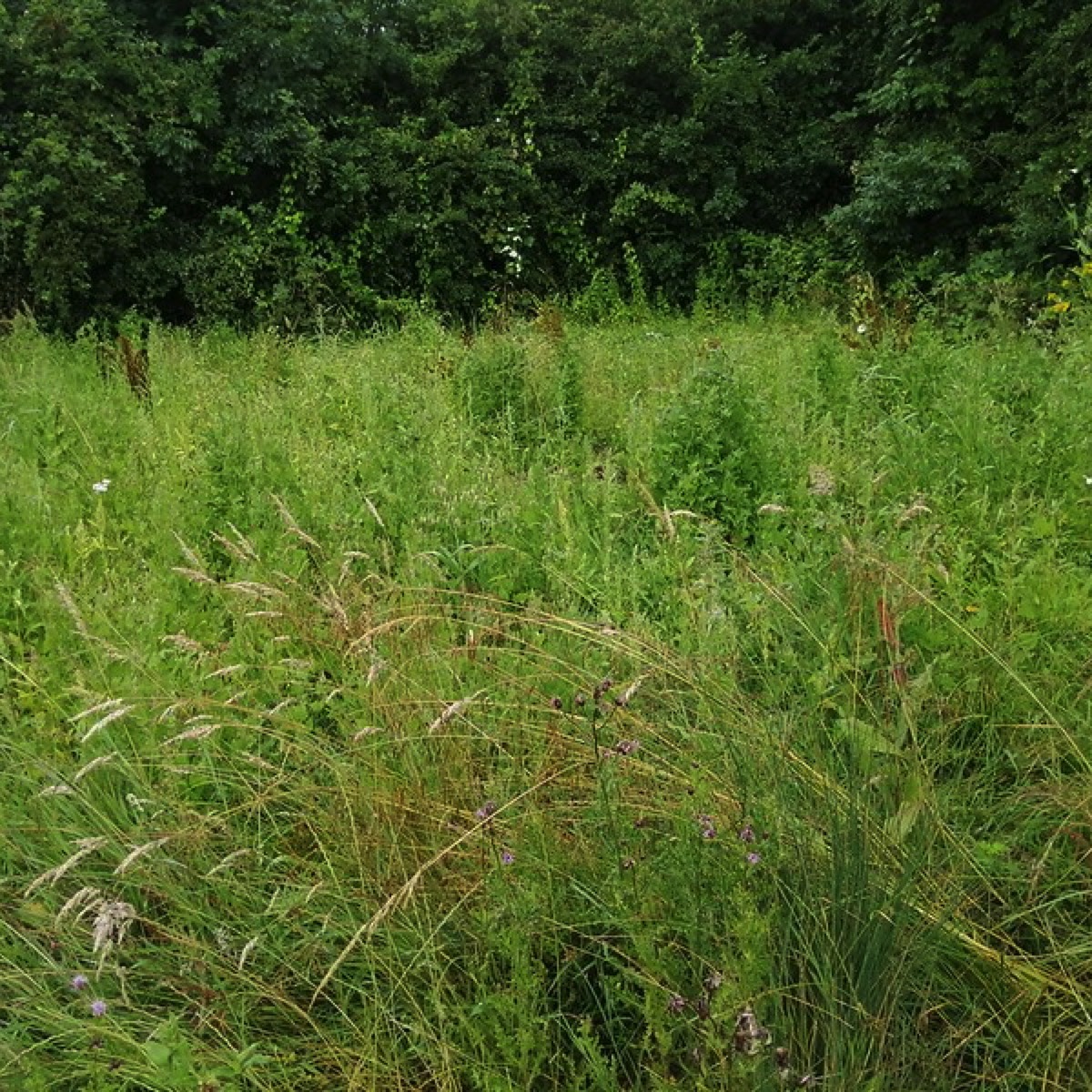
Soil is a Living System
The Wood-Wide-Web
One of the other key reasons not to disturb your soil more than is absolutely necessary for planting, is the existence of a vast network of fungi, a soil infrastructure if you like, which connects your plants to those many metres, and maybe even miles away. Mycorrhizal fungi live in the soil, where they create a network of filaments, which can spread over vast distances. In his stunning book, The Hidden Life of Trees, forester Peter Wohlleben describes how a single fungus can spread across an entire forest and live for thousands of years. They are the biggest living organisms on the planet, but generally all we ever see of them is their fruiting bodies: the mushrooms and toadstools that appear in the autumn damp. The web of filaments – or mycelia – surround, connect with and penetrate plants’ roots, massively extending their ability to take up both nutrients and water. In a forest, the network not only enables individual trees to access more water and vital nutrients, it connects every tree to the rest, transporting nutrients from the most vigorous to others in greater need. The ‘wood-wide-web’ also passes on alarm signals that alert distant trees to impending danger from insects, drought or fire. This is all mind-bending stuff and, in combination with stunning photographs, The Hidden Life of Trees is a hard-back book that’s well worth its price.
You find twice the amount of life-giving nitrogen and phosphorus in plants that cooperate with fungal partners than in plants that tap the soil with their roots alone.
Peter Wohlleben
In exactly the same way, the fungi in your garden soil form a network, breaking down the organic matter within it, releasing nutrients which would not otherwise be available to your plants and transporting them between plants. Imagine then, how disruptive it is for this sophisticated network, to have a gardener coming along with a fork each year, breaking the soil and its networks into little pieces and turning everything upside down.
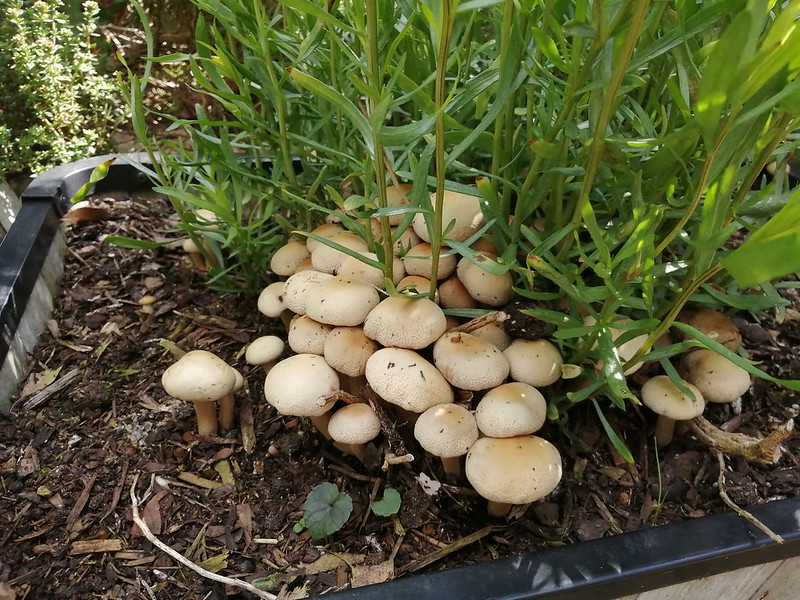
My French tarragon tub surprised me with this extra crop of mushrooms. The spores probably came from mushroom waste in my home-made compost but I wasn't certain enough of their species to eat them. They did no damage to the tarragon at all but were living happily with it. If I can get a definite identification that they are edible I may have two edible crops from one tub next year.
Beneficial Bacteria
The fungi are helped in supplying nutrients to plants by an army of beneficial bacteria, which carry out a wide range of tasks, from decomposing organic material and so releasing nutrients, to fixing nitrogen from the atmosphere into a form which makes it available to plants. If you have ever read that beans and peas are good for feeding your soil, this is why. You can see the effects of these bacteria if you pull up a bean plant and see little pink bobbles on its roots, known as nitrogen nodules. Unfortunately, you can't have your cake – or nitrogen – and eat it. The plants will either store the nitrogen in their roots or use it to create your beans. If you want to improve your soil with beans or peas you will need to cut the plants before they set seed, leaving the roots in the ground and composting the tops for extra humus.
Nitrogen Nodules on a bean plant
From the perspective of a person with fibromyalgia, who has had to do a lot of work with a nutritionist to balance my own gut flora, I find it fascinating to think about the parallel between the role of beneficial bacteria in plant and human nutrition. For an extremely readable book about the gut and how important bacteria are in feeding us, try Gut by Giulia Enders.
Millions of Mini-beasts
Digging not only disturbs the network of fungi and bacteria which help to feed your plants, it creates problems for the millions of mini-beasts for whom soil is home. You may not like 'creepy crawlies' but they are essential for healthy soil and plants. Easily visible creatures like worms, beetles, ants, woodlice, wasps, flies and slugs all eat plant and animal matter, converting it into humus, while opening up channels and spaces between the soil crumbs. While some may also create problems by eating your plants, they in turn are food for the carnivorous predators. The life in your soil is a complex and wonderful web: kill, or even significantly reduce, the 'pests' and the food chain in your garden collapses. It's worth noting that not all slugs eat living plants; some are specialists in clearing away dead leaves.
if you look at a soil sample under a microscope, even more creatures appear: springtails, nematodes, mites and then the even tinier protozoa . . . Just one teaspoon of soil contains more lifeforms than there are people on planet earth (Soil Association). This tiny world can be as fascinating to learn about as the more commonly understood wildlife in your garden. It's possible – and a lot of fun – to buy a mini microscope that plugs into your phone / laptop with a USB connector for around £30.00.
if you look at a soil sample under a microscope, even more creatures appear: springtails, nematodes, mites and then the even tinier protozoa . . . Just one teaspoon of soil contains more lifeforms than there are people on planet earth (Soil Association). This tiny world can be as fascinating to learn about as the more commonly understood wildlife in your garden. It's possible – and a lot of fun – to buy a mini microscope that plugs into your phone / laptop with a USB connector for around £30.00.
An earthworm in a no dig field in the USA
Feed Your Soil, Not Your Plants
This understanding of the nature of soil underpins the organic principle, feed your soil, not your plants. While some essential nutrients come from the mineral portion of the soil, they are not always in forms that plants can absorb through their roots. Most of the nutrients that plants need most, and can access, come from the humus. For example, when leafy green plant material decomposes in your compost heap it adds a lot of nitrogen to the compost, which is important for green, leafy growth. Organic matter also contributes phosphorus and potassium, two other key nutrients which are essential for good root and fruit growth. You will often see these three nutrients abbreviated as NPK on packets of fertiliser.
Plants take up nutrients that are dissolved in water through their roots. When you use a liquid fertiliser the nutrients are available all at once, the plant equivalent of an energy drink. Just as an energy drink gives you a quick buzz of energy, often followed by a crash, much of the goodness in liquid fertilisers quickly drains out of the soil with the water, leaving your plants lacking.
Plants take up nutrients that are dissolved in water through their roots. When you use a liquid fertiliser the nutrients are available all at once, the plant equivalent of an energy drink. Just as an energy drink gives you a quick buzz of energy, often followed by a crash, much of the goodness in liquid fertilisers quickly drains out of the soil with the water, leaving your plants lacking.

To make matters worse, the large scale use of liquid fertilisers in agriculture causes major problems when nitrogen-rich fertilisers wash into rivers and streams. This upsets the natural balance, feeding algal blooms which grow so quickly that they use up the oxygen within the water, causing other aquatic life to die.
Fertiliser granules release their nutrients more slowly but add nothing more than nutrients. They do nothing to replace the bulky organic matter needed to maintain your soil’s structure. Feeding your soil with compost or manure combines both the necessary bulk for structure and slow-release nutrients, which are made available gradually over many months through the action of bacteria and fungi. Compost and manure have the added benefit of containing their own colonies of bacteria, fungi and larger animal life, which add to the bio-diversity of your soil and therefore its health.
So if digging is bad for your soil as well as for your health, what is the alternative?
No-Dig Gardening
I began this page with a description of how adding organic matter in the form of compost or manure lies at the heart of the tradition of double digging. Gardeners dig a deep trench and fill it with manure, covering this over with the soil from the next trench. This is believed to aerate the soil and enable birds to reach pests, as well as incorporating the compost into the soil.
Recent science has challenged all of these beliefs and many people have turned to no-dig-gardening in which they lay the organic matter on the surface of their soil, allowing the worms to draw it down and incorporate it, doing the digging for them in a much less traumatic way. While this is happening, the rain is unable to wash the nutrients from exposed soil, and the wind cannot blow it away. The thick layer of compost also serves as a mulch, helping to retain moisture and preventing weed seeds from germinating, thus reducing your workload considerably. Have a look on my Weeding page to find out how no-dig gardening reduces the germination of weed seeds and massively reduces your workload.
Of course it is necessary to disturb the soil in order to take out a big perennial root, sow seeds or plant out new plants, but this is kept to a minimum and over time, there will be far fewer weeds and therefore much less need to disturb the soil to remove them.
For much more on No Dig gardening, have a look at Charles Dowding's No Dig Organic Gardening website.
For ideas on how to create a no-dig bed that suits your needs, have a look at my Activities page.
If this page whets your appetite for more soil science, Garden Organic produce an excellent Soil Information Pack, full of detailed information, that will also show you how to test your soil to assess its health and characteristics.
The Soil Association also have a very informative report online Living Soils A Call to Action with masses of soil science as well as more on the global issue of soil degradation.
Recent science has challenged all of these beliefs and many people have turned to no-dig-gardening in which they lay the organic matter on the surface of their soil, allowing the worms to draw it down and incorporate it, doing the digging for them in a much less traumatic way. While this is happening, the rain is unable to wash the nutrients from exposed soil, and the wind cannot blow it away. The thick layer of compost also serves as a mulch, helping to retain moisture and preventing weed seeds from germinating, thus reducing your workload considerably. Have a look on my Weeding page to find out how no-dig gardening reduces the germination of weed seeds and massively reduces your workload.
Of course it is necessary to disturb the soil in order to take out a big perennial root, sow seeds or plant out new plants, but this is kept to a minimum and over time, there will be far fewer weeds and therefore much less need to disturb the soil to remove them.
For much more on No Dig gardening, have a look at Charles Dowding's No Dig Organic Gardening website.
For ideas on how to create a no-dig bed that suits your needs, have a look at my Activities page.
If this page whets your appetite for more soil science, Garden Organic produce an excellent Soil Information Pack, full of detailed information, that will also show you how to test your soil to assess its health and characteristics.
The Soil Association also have a very informative report online Living Soils A Call to Action with masses of soil science as well as more on the global issue of soil degradation.
My illness has meant that I have had to give up my work and so I am now looking to find a new career through my writing. If you have enjoyed this page and would like to encourage me to produce more, click the coffee cup below to make a small donation; no strings, no fuss, just a little, 'Thanks, keep it up.'
You can also help by sharing this page on your social media.
